The Definitive Shure SM57 Review
Possibly the most versatile mic in the world with an astonishing price tag
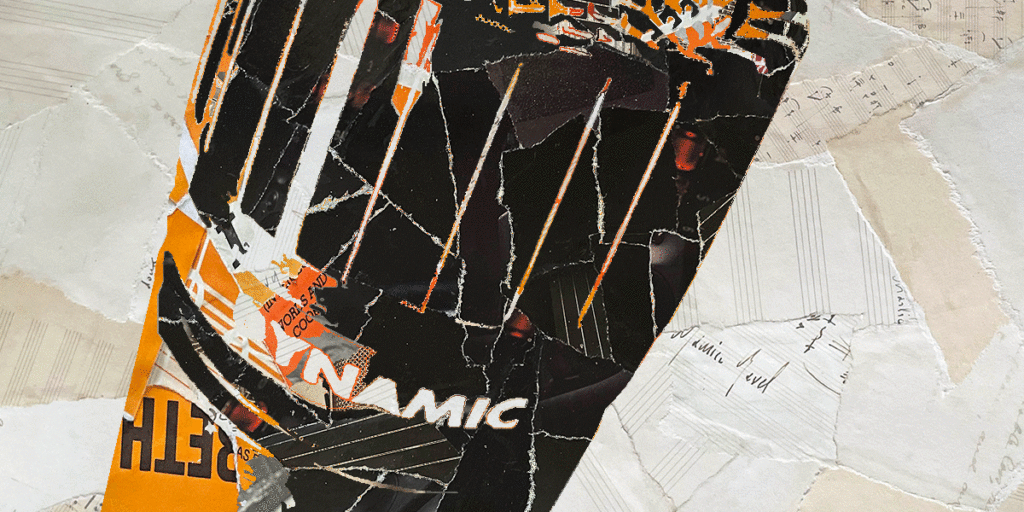
Reviewed by: Paul Narang
Review date: November 2023
Price: Around $100
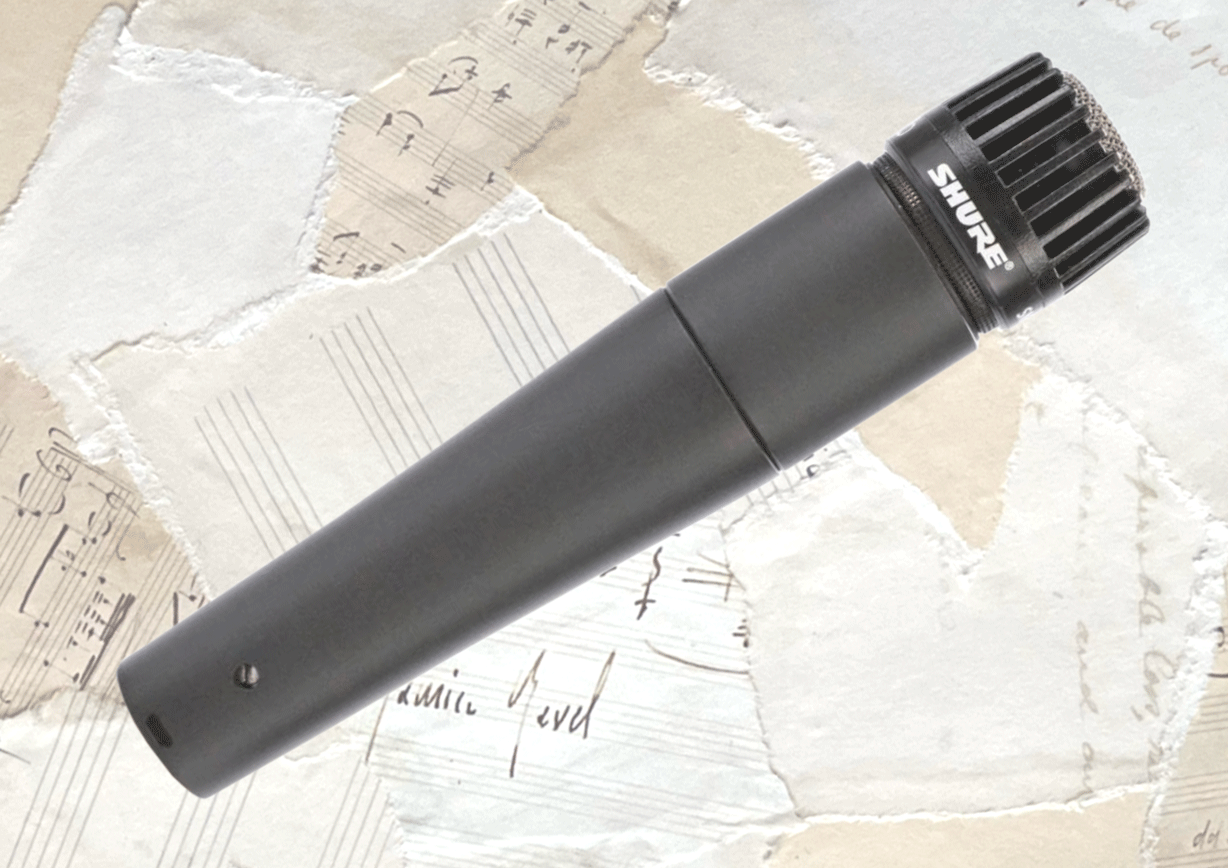

Shure SM57 Review
| Pros: | Cons: |
| Very durable Excellent noise rejection Extremely versatile Great value | Sensitive to plosives |
Shure SM57 Review
The Shure SM57 is a legendary dynamic microphone, a staple of studios and live shows around the globe. It’s known for a combination of smooth, reliable sound and near-indestructible build quality. A super versatile mic, the SM57 performs well on drums, guitars, guitar amps, spoken-word and more. It’s also great value, retailing for less than $120.
What is it?
The Shure SM57 is one of the most widely used microphones in the world. It’s a dynamic mic, with a cardioid polar pattern. The SM in the name stands for ‘Studio Microphone’, but its also a favourite amongst live performers thanks to its durability and superior noise rejection.
Shure, a company with its long history of producing classic microphones, have been pioneering directional dynamic mics as far back as the 1930s. They introduced the SM57 in 1965, which quickly became a go-to for sound engineers and musicians alike. It’s been used on the podium at the White House since it was released, which is a testament to both its reliability and sound quality.
The SM57 was one of the first mics I bought, and it’s been in regular use in the studio and on stage for many years. I find it great for miking up acoustic guitars, guitar amps, and a whole range of other instruments. Whilst it’s not my first choice for recording lead vocals, it works very well on spoken word.
You’ll also see the Shure SM57 at most live gigs, noticeably on drums, horns and guitar cabs.
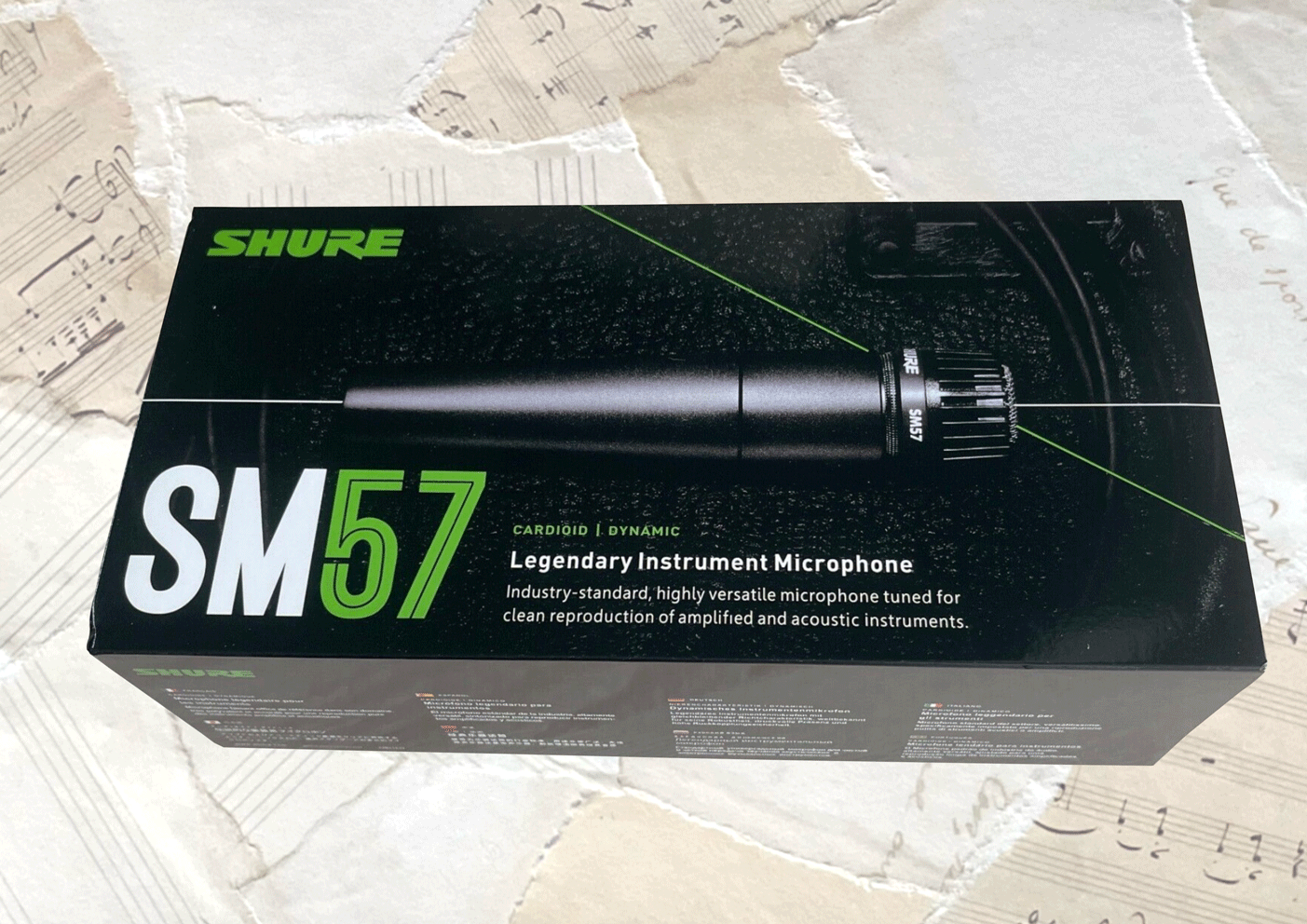
In the box
Inside the box you’ll find:
- Microphone
- Pouch
- Mic Clip
- 3/8″ Thread Adapter
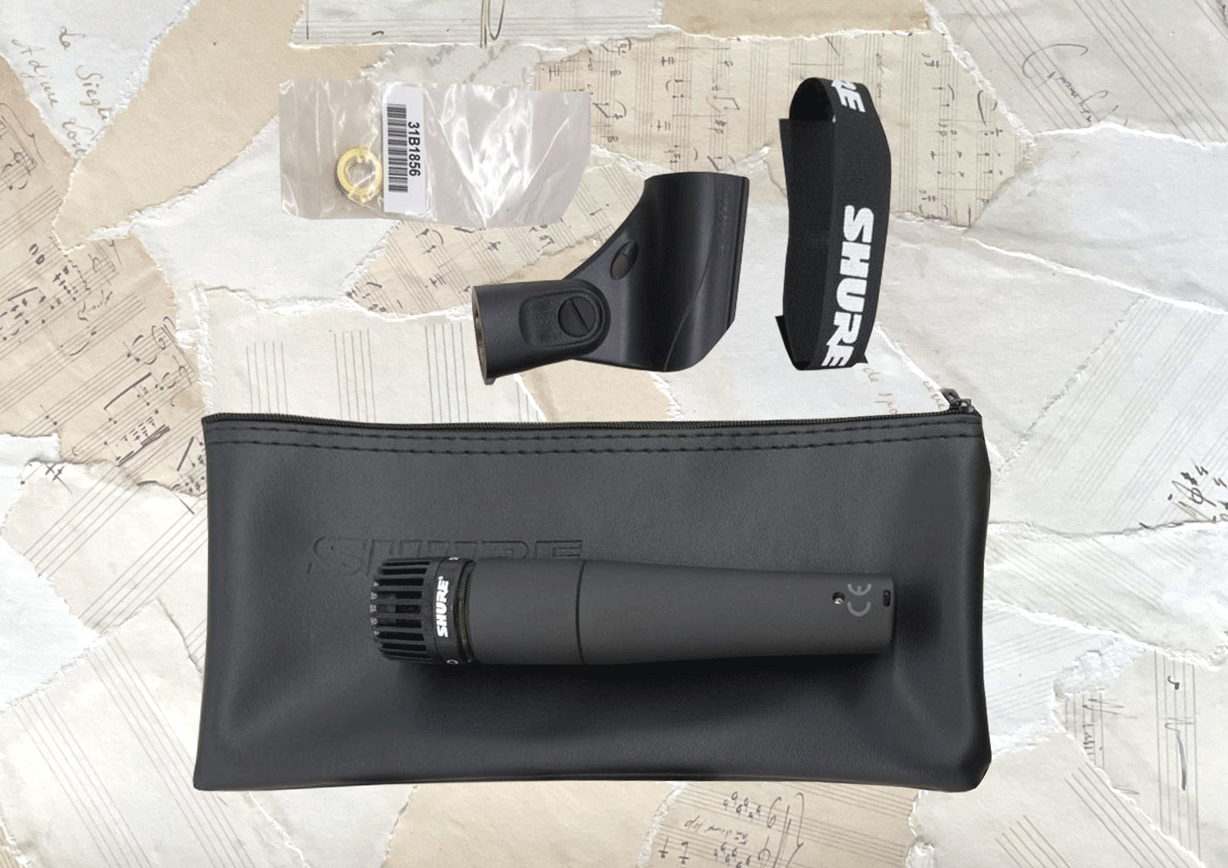
Dynamic vs condenser microphone
The Shure SM57 is a ‘dynamic’ mic, making it particularly suitable for live use. Dynamic microphones differ to condenser mics in the following ways:
- They’re less sensitive (suitable for loud sounds)
- They’re less prone to feedback on stage
- They’re more rugged and durable for live use
- They’re cheaper
- There’s no need for batteries or phantom power
Dynamic mics in the home recording studio
Although dynamic mics are regularly used in live performance, they also have a unique place in the studio. The lack of sensitivity might sound like a drawback, but it can also work to your advantage.
A dynamic microphone, particularly one with a cardioid polar pattern, will pick up less of a poor sounding room, street sounds, or distant traffic rumble. It’s also the ideal choice for loud instruments such as drums and brass.
They also have their own tone, and can be used to tame shrill sounding instruments, or to add darkness and grit to overly bright vocals.
SM57 Polar pattern
Like many dynamic microphones the Shure SM57 uses a cardioid pickup pattern, which is a heart shape. It picks up sound from the front, but rejects sound from the back and sides. This makes it ideal for use on stage, where you can isolate the vocals from other noisy instruments.
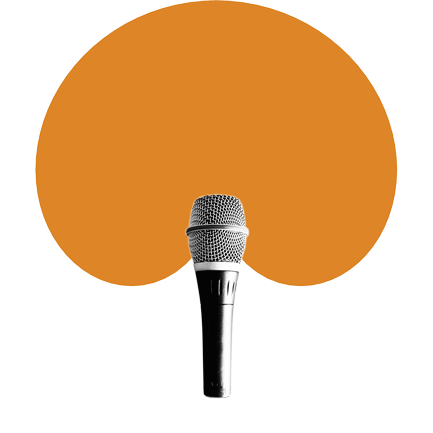
The Shure SM57 vs SM57-LC vs SM57-LCE
The Shure SM57 and the SM57-LC are the same model. LC used to stand for ‘less cable’, as there were two versions available to buy – one with an one without an included cable. There’s just the option without a cable now, which to confuse matters further, is also known as the Shure SM57 LCE.
Is there an on/off switch on the Shure M57?
There’s no on/off switch on the SM57 – this adds to the robust simplicity of the microphone, leaving less to go wrong while you’re live on stage. It’s common for pro-level microphones designed for the stage to lack an on/off switch, as the sound tends to be controlled by the audio engineer. And they want to make sure the vocalist doesn’t accidentally switch the mic off.
If you really need an on/off switch, you could buy the similar SM58S (rather than the Shure SM58LC). Another alternative with a would be the 545SD-LC, which shares the same Unidyne III element as the SM57 and includes a switch.
Phantom power for the Shure SM57?
The Shure M57 is a dynamic mic, which means it doesn’t require any form of external power. There’s no need for batteries, or ‘phantom power’ from the audio interface or mixer. This does make the signal a little lower than a condenser mic, which is powered to increase the volume.
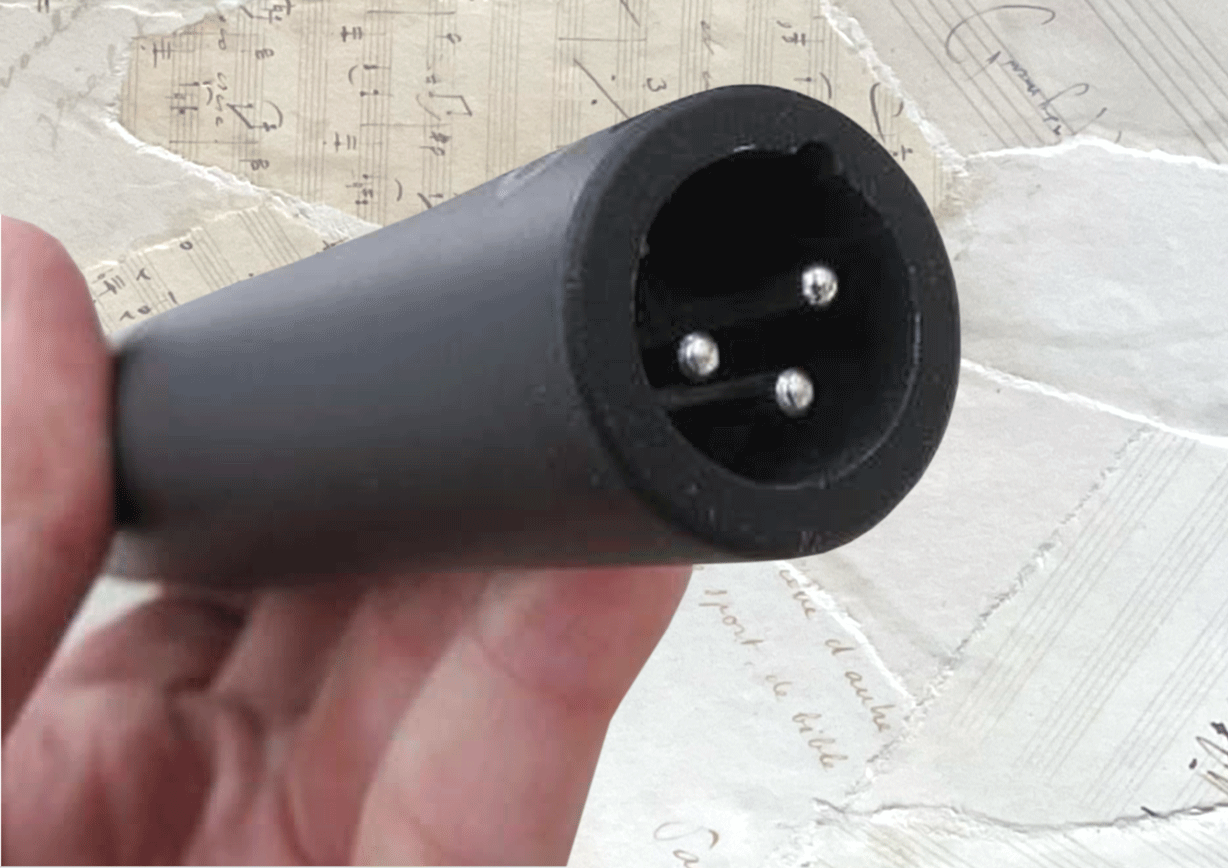
Connecting the Shure SM57
The SM57 uses an XLR cable to connect directly to an audio interface or mixer. XLR are the standard connectors on all professional studio equipment. They’re ‘balanced’, which means the cables are shielded from interference and carry a higher signal than unbalanced cables.
If your audio interface or mixer has 1/4″ jack inputs, you’ll need a cable with an XLR connector on one end, and a 1/4″ jack on the other, like this. Keeping cable lengths to a minimum is good practice to maintain the best signal.
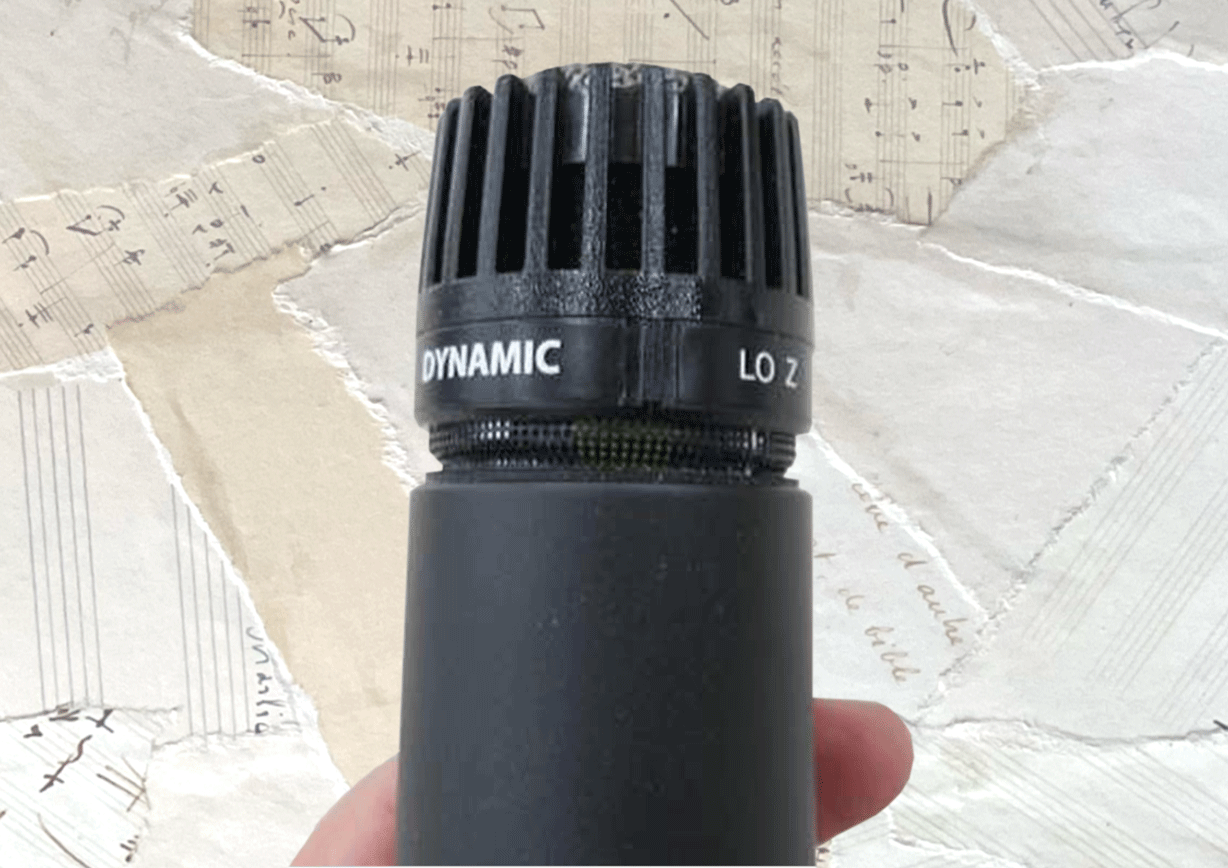
The Shure SM57 design and build
The design of the Shure SM57 is simple and durable, with no unnecessary bells and whistles. The integrated pneumatic shock mount reduces bumps and stand noise for live use.
The SM57 is an end-address mic, with a smooth cylindrical metal body. The internal cartridge and the grille are connected as part of an integral resonator/grille assembly.
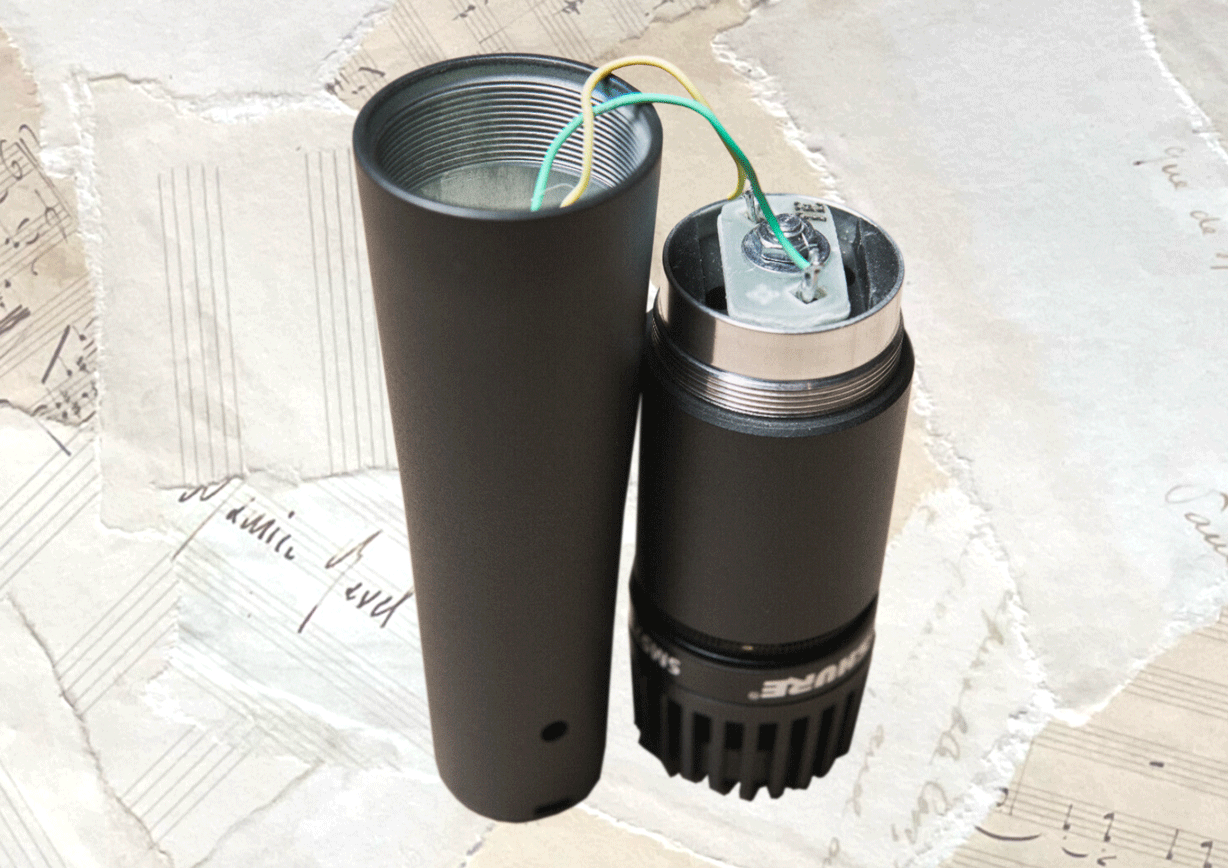
Inside it uses the same dynamic capsule as the SM58. But in place of the SM58’s bulb-shaped grille and built-in pop filter, is a shorter flatter grille. The reduced size makes it easier to get the SM57 closer to instruments, reducing feedback on stage, and adding to the proximity effect.
Shure have a long history of making mics that cope well with the rough and tumble of touring, and the SM57 is no exception – it’s known for being close to indestructible. A quick youtube search will bring up many videos of people doing their best to destroy it – smashing it with a hammer, dunking it in water, or even running it over with a car.
Shure SM57 Dimensions and Weight
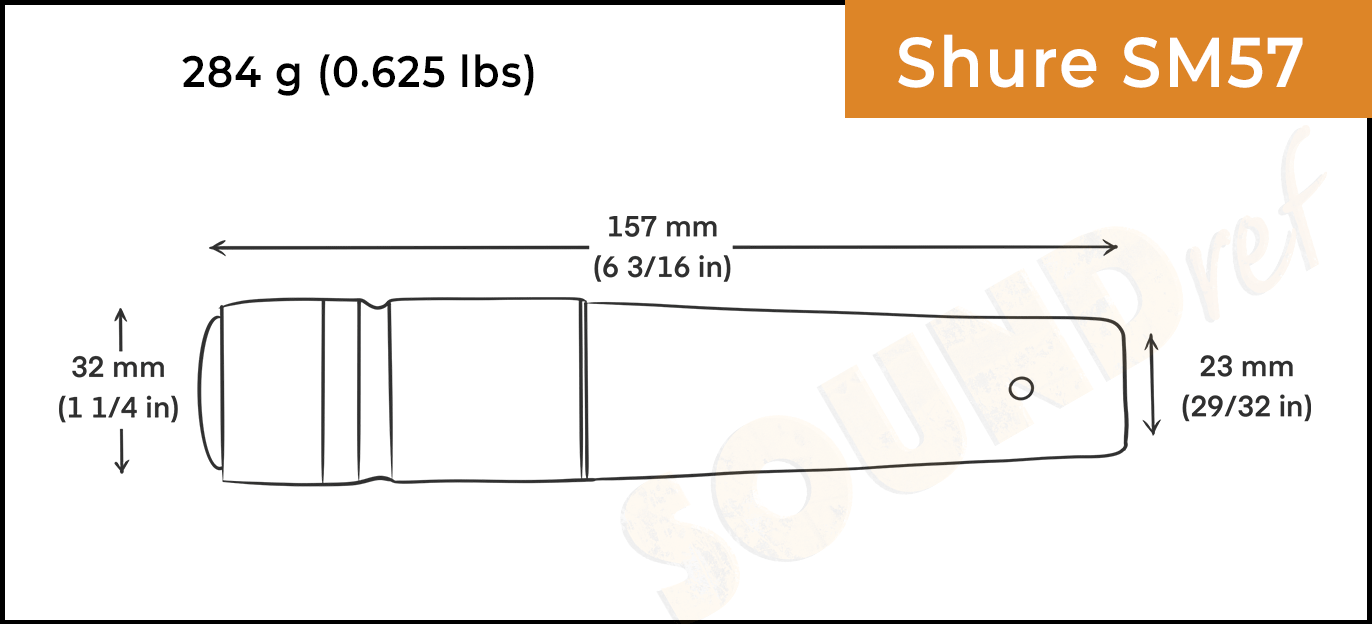
The Shure SM57 is small, portable, and has a nicely balanced weight to it.
Dimensions:
- 157mm (1 1/4 inch) length
- 32mm (6 3/16 inch) head width
- 23mm (29/32 inch) end width
Weight:
0.284 kg (0.625 lbs)
Shure SM57 Frequency range
The Shure SM57 has a frequency response of 40 Hz to 15 kHz. There’s a slight peak in the bass around 200 Hz – handy for recording guitar cabinets, toms or spoken word. Below 40 Hz the frequency continues to drop away, keeping your recording free of low frequnecy rumble.
There’s a small dip between around 300 to 600Hz which helps reduce muddiness in the low mids. Above this the response remains fairly flat, until a presence boost from around 3kHz up to 6kHz. This is what makes the SM57 great for capturing the ‘snap’ of a snare, or the ‘twang’ of a guitar. From around 9kHz upwards the response slowly falls away, with very little sensitivity above 15kHz.
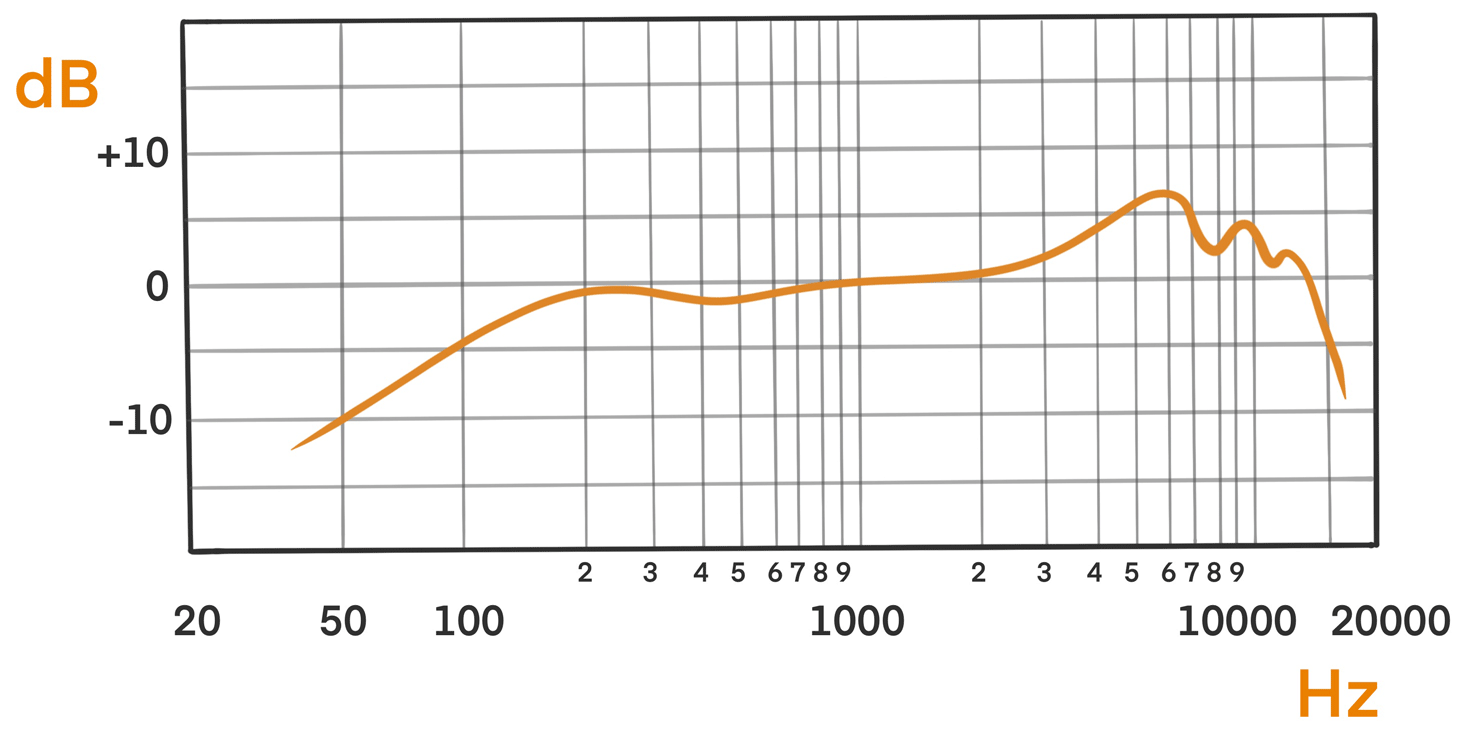
Inevitably, the top-end of the SM57 isn’t as bright as many studio condenser mics. By comparison, the Rode NT1-A extends all the way up to 20kHz. But the reduced top-end does have its advantages – you’ll pick up less room ambience and subdue the shrill highs of a harsh instrument.
SM57 Sensitivity and Impedance
The SM57 has a cardioid polar pattern, which is great at rejecting noise from the front and sides. I tested the pickup pattern on my voice by slowly rotating the microphone as I spoke. I found that as soon as I was side on, at 90° to the mic, the sensitivity dropped dramatically. This stayed consistent around the rear of the microphone, as well as on the other side.
The SM57 has a low sensitivity rating of -56 dBV, which is useful for a number of reasons. Low sensitivity mics are generally much better at rejecting room noise. With the SM57, I found that as I moved more than about 2ft away from the mic it picked up far less of my voice. This is a godsend for anyone recording in noisy, or untreated rooms. Also great for avoiding bleed if you’re miking up a few different instruments.
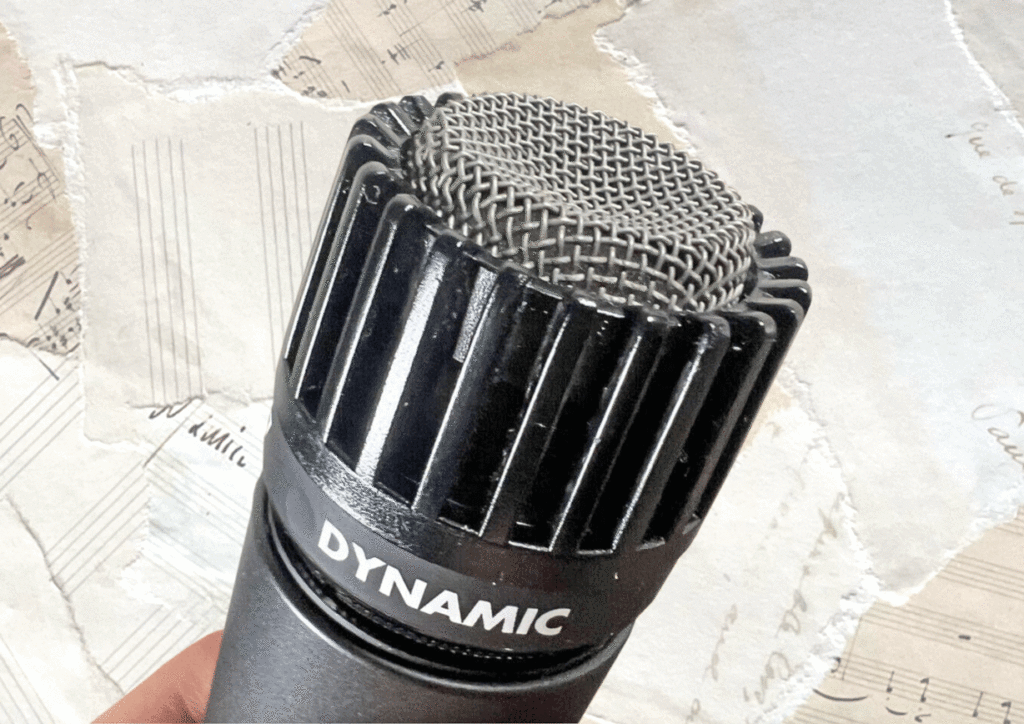
The Shure SM57 can also cope with really loud sounds. Depending on the frequency, the max SPL ranges from 150db to 190db, all of which is way louder than even the loudest guitar amp. In most settings, nothing is too loud for this mic.
One potential downside of this lower sensitivity, is that you need quite a lot of gain to get it up to line level. The SM57 requires 56db of gain, but this should be achievable on most mixing desks or audio interfaces. If you need more gain, you can always use a preamp like a Cloudlifter or Fethead.
The mic has a low impedance of 310 Ohms, which helps carry the signal from mic to amp with minimal distortion.
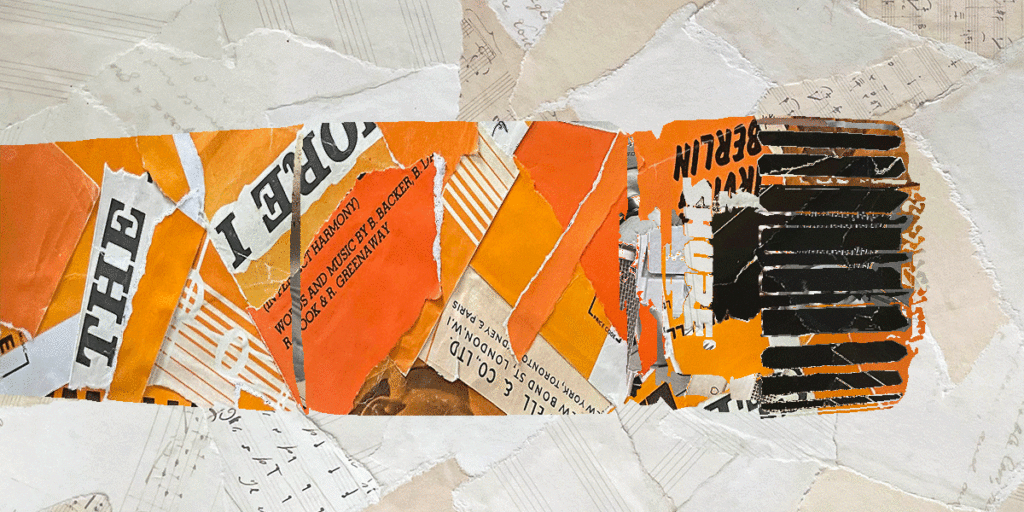
SM57 Sound quality
There’s a good reason why the Shure SM57 is one of the most popular microphones in the world. As well as durable build quality and great noise rejection, its a great mic for consistent audio quality on stage and in the recording studio.
It’s never going to be as sparkly and bright as a studio condenser mic, but the SM57 does have a consistent, warm tone. There’s plenty of body, and just enough top-end to be useful in a wide range of situations. Personally, I wouldn’t use this for lead vocals in the studio, unless I needed more proximity effect, which the shorter grille enables.
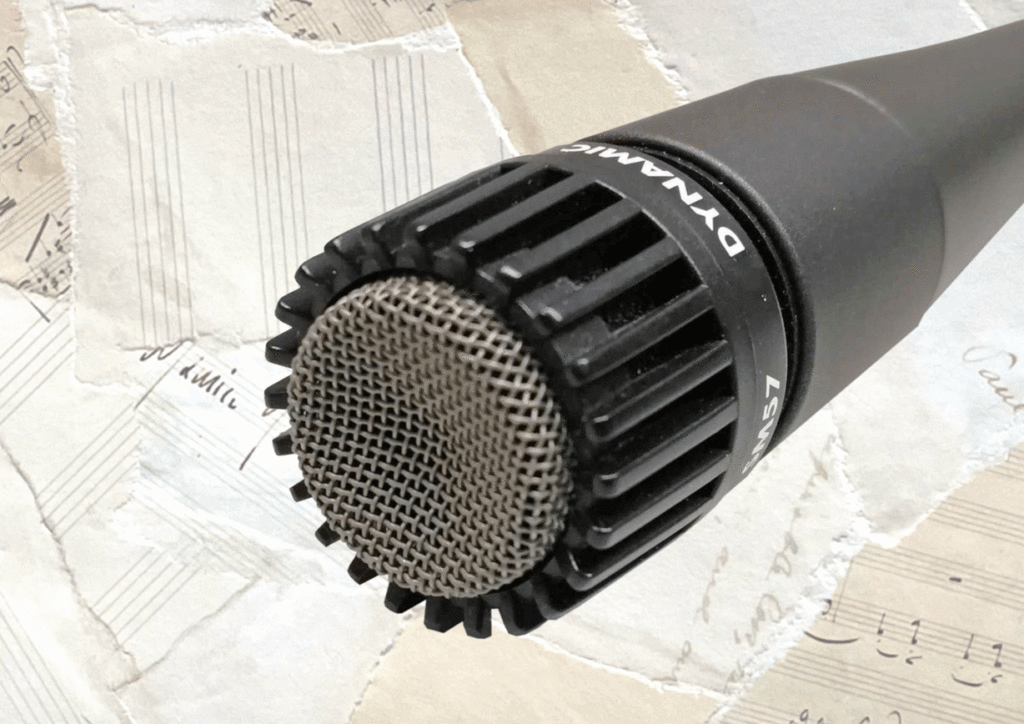
I do routinely reach for the SM57 for recording drums, guitars, and brass instruments. I find the presence boost particularly flattering on snares and electric guitars, as it doesn’t add too much brightness. It’s also lovely on spoken word. With a pop shield and the right mic position, you can easily get a remarkably warm and even sound.
Shure SM57 for recording vocals
Although the SM57 wasn’t designed as a vocal mic, it has the same cartridge as the SM58. The two mics are nearly identical, but the lack of a pop filter means it’s quite sensitive to plosives. Shure do make their own foam windshields if you need one, which are compatible with the SM57 (the A2WS and A81WS).
You can also use an external pop shield if you have one lying around which should work just as well. The SM57 is quite sensitive to the proximity effect, but I find using a pop shield keeps me a good distance from the mic when recording.
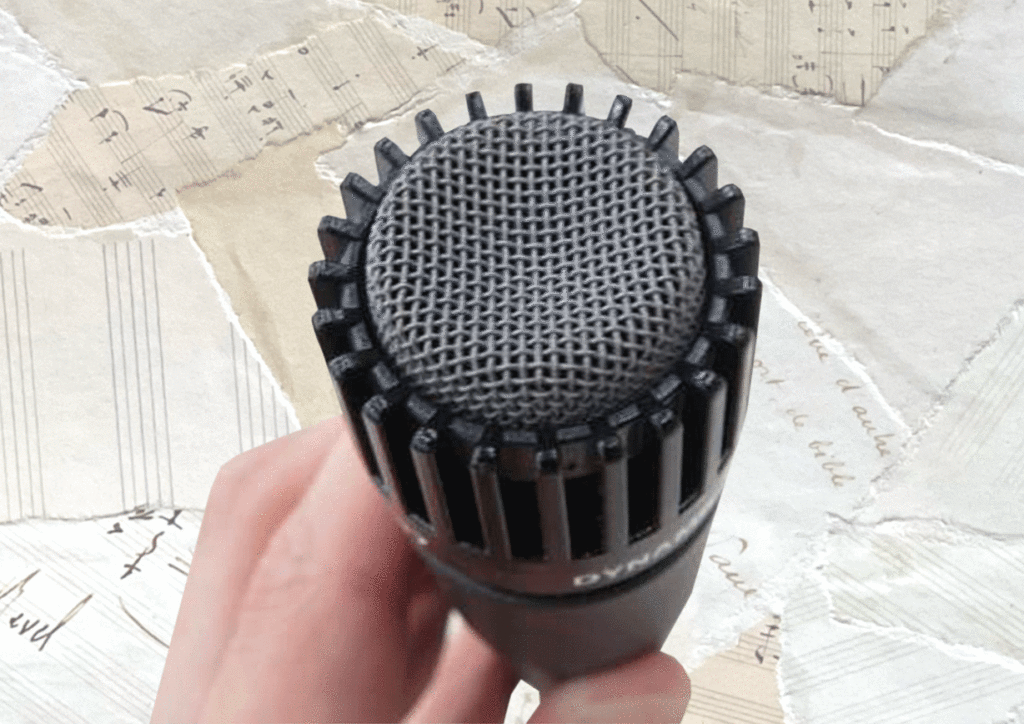
It isn’t normally my first choice for lead vocals, but I’ve used it for multitracking backing vocals which works well. With a windscreen it has a similar warm tone to the more expensive Shure SM7B, which is often used on podcasts and radio. If the SM7B is out of your price range, then this could be the next best thing for spoken word.
Shure SM57 for recording guitar
The SM57 is great on acoustic guitar. I’ve used it with success on my smaller than average acoustic guitar which lacks the bass of bigger models and sounds quite bright. It’s a good fit, with the SM57 adding a subtle bass boost, and the rolling off the top end, for a nice get a nice warm tone.
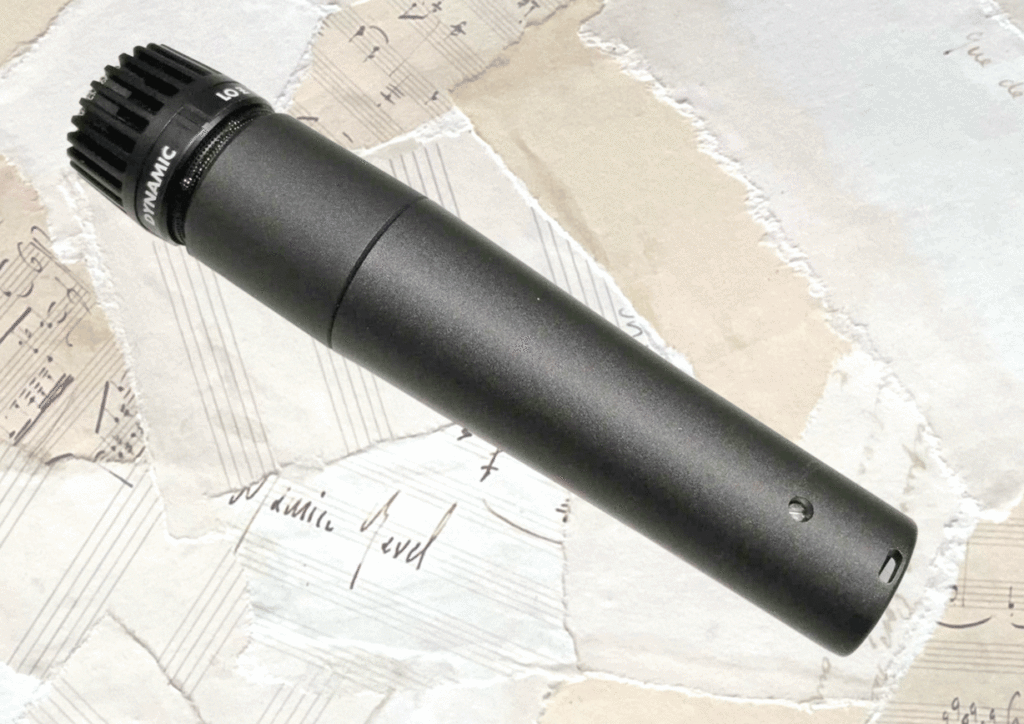
If I’m working on an arrangement with multi-tracked guitars, I’ll often just use a single mic, as several mono tracks are easy to mix. But when I’m recording a featured guitar track, I’ll use two mics for a fuller stereo effect.
I think the Rode NT1-A makes a good partner to the Shure SM57. The NT1-A is a large diaphragm condenser mic which compliments the darker tones of the SM57 with its brightness and clarity.
Try placing the Rode near the bridge, with the 57 roughly level with the 12th fret, pointing towards the sound-hole. The NT1-A provides the detail and sparkle, whilst the SM57 adds the warmth, depth and body.
Shure SM57 in the studio
If you have an SM57 in the studio, I’m sure you’ll fend plenty of uses. It’s a mic you can put on most sound sources, especially when you only need a mono recording for multi-tracking.
It sounds amazing when recording electric guitar cabinets – the high SPL of the 57 means you can crank the cab to eleven without ever worrying about overloading the mic. And the flat grille means you can place this dynamic microphone up close for a beefy tone. The smooth high frequency roll-off of means it won’t sound too harsh on the distorted guitar.
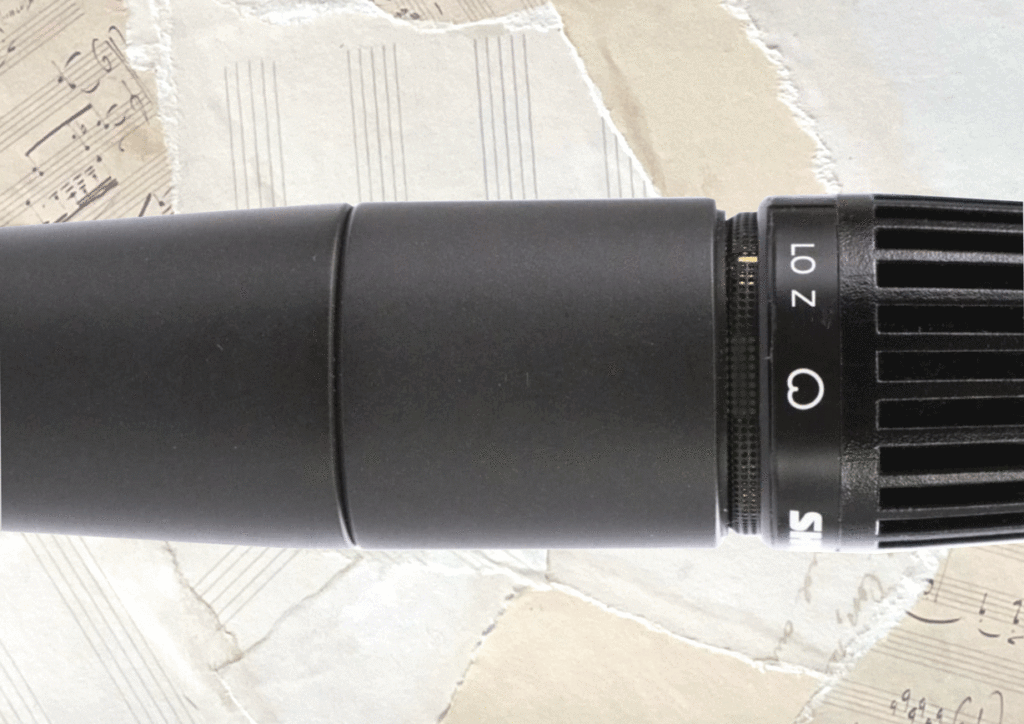
I’ve also used the SM57 to record an upright piano, pairing it with a condenser mic as I do for acoustic guitar. The combination of complimenting tones produces a rich, detailed piano sound with a wide stereo image. If you’re looking for a more rocky sound, a single SM57 might be all you need.
The SM57 is also a popular choice for miking up drums, which need to be able to handle loud sound sources. The warmth and snap is perfect for snare drum, toms, and even the kick drum.
The Shure SM57 in live use
It’s not often I go to a live gig without seeing at least one SM57 onstage. It’s one of those rare mics equally lauded for studio and live applications.
The reason the SM57 is so popular at live gigs live gigs is the excellent noise rejection, which is so important for minimising stage bleed and feedback. There’s also the high SPL, making it difficult to overload, and of course the tank-like build quality and ruggedness.
Just as in the studio, you’ll see SM57s on guitar amps and guitar cabs and miking up snares and toms on stage. Many live sound engineers have several SM57’s ready to go, just to make sure they can cover all eventualities.
The intriguing background of the Shure SM57
The SM57 (1965) and SM58 (1966) were based on Shure’s popular ‘Unidyne III 545’ of 1959. This was a mic developed by Ernie Seeler for PA systems, and it already incorporated a pneumatic shock mount. Reliability and strength were important to Ernie, and Shure report that he tested the mic by “dropping, cooking, freezing, and submerging it”.
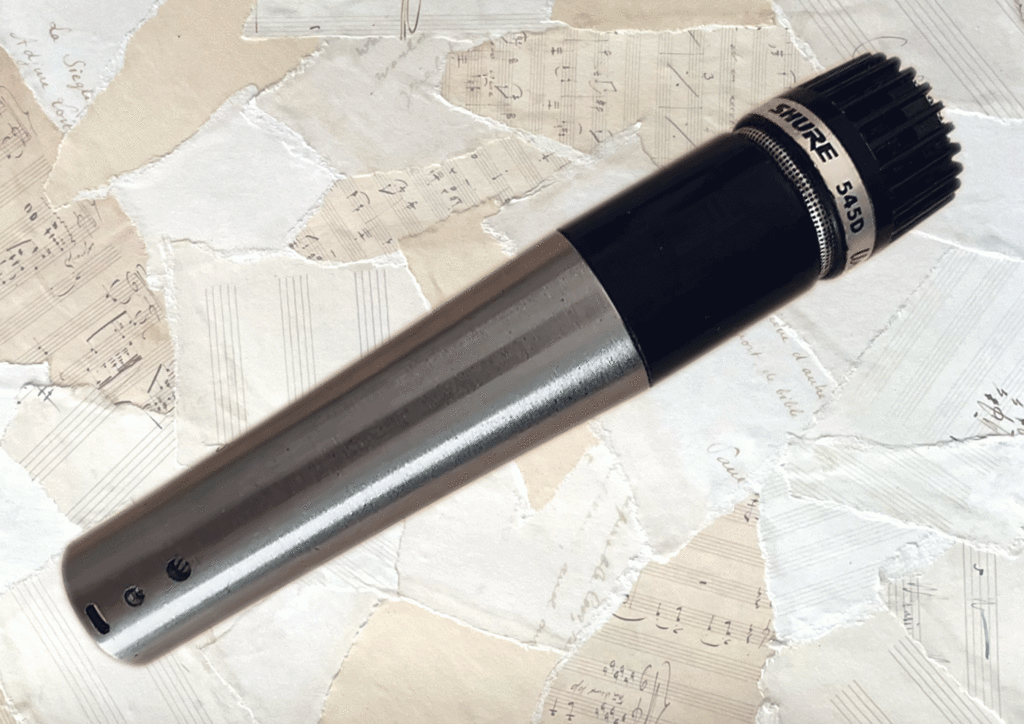
For the SM series, Shure decided to loose the on/off switch, retain its durability, and promote it for broadcast use. SM originally stood for ‘studio microphone’
But the company found the broadcast market a difficult nut to crack, due to stiff competition by established companies, such as RCA, EV and AKG. Sales were slow, and Shure began having discussions about discontinuing both the SM57 and SM58. It wasn’t until they began pitching the SM series to live sound engineers, that the mics found their natural market.
Shure SM57 vs Shure SM58
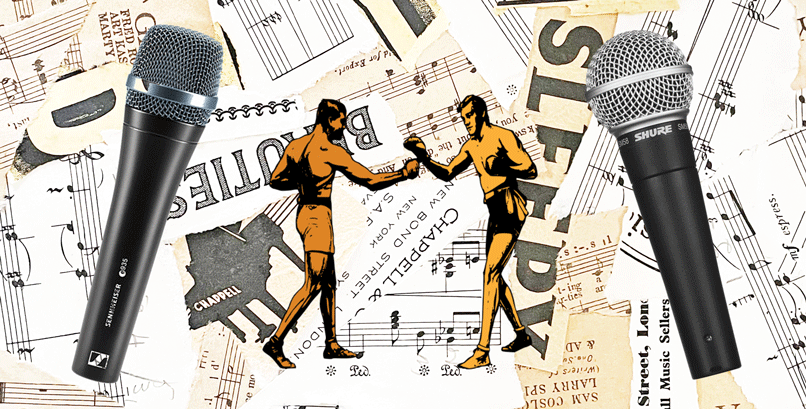
The SM58, one of the most widely used microphones of all time, has been an industry standard for live vocals for years. Both of these similar mics were developed by Shure in the mid 60s.
They share the same mic capsule design and internal circuitry, and have a similar frequency range, with the SM58 starting just slightly higher at 50Hz, compared to the SM57’s 40Hz.
The difference is in the grille. The SM58 has a round bulb-shaped grille with a built-in pop filter, whereas the SM57 has a shorter, flatter grille with no pop filter. The short grille of the SM57 means you can get it closer to an instrument, and increase the proximity effect, for more bass.
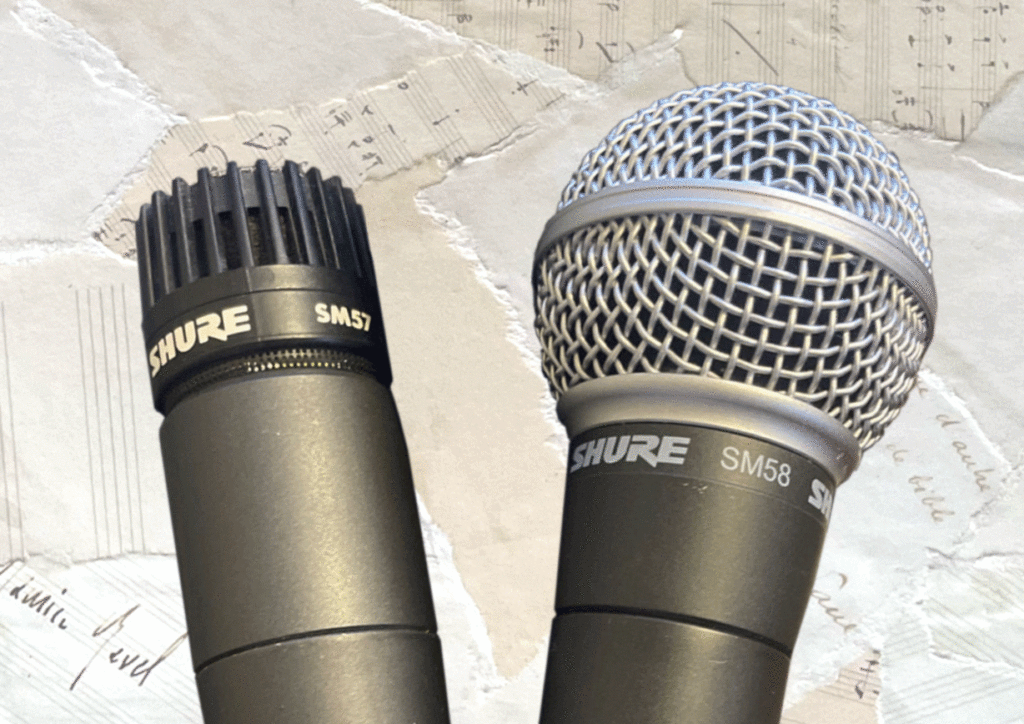
The two microphones have similar frequency responses, but there are some small differences. The SM57 is capable of capturing bass down to 40 kHz, compared to the SM58, which starts around 50 kHz. It has a gentle bass roll off, arriving at a smooth plateaux at 1200 kHz. In contrast, the SM58 has a steeper bass roll off, starting at 50Hz and quickly arriving at a flat section at 100 Hz.
The main other difference is in the higher frequencies. The SM57 has an increased boost in the high frequencies at around 6 kHz. It’s a slightly brighter mic than the SM58, and although the SM58 is the go to mic for vocals, the SM57 might occasionally be more suitable for vocals that would benefit from that high frequency boost.
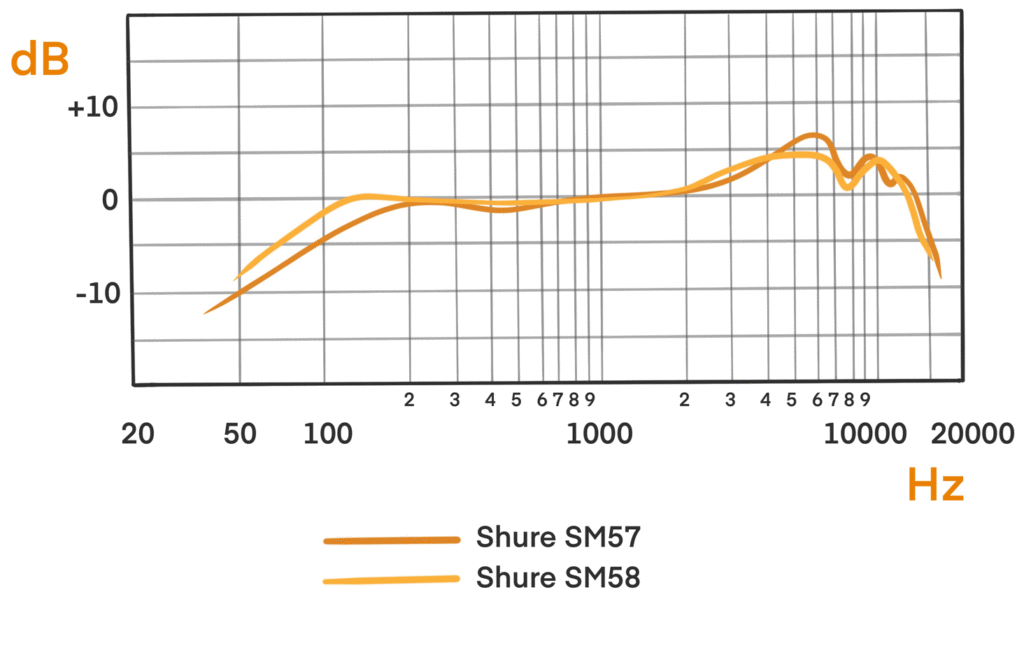
I do sometimes struggle to tell the difference between the two mics, but I’d generally reach for the SM57 over the SM58 when I’m trying to capture more bass, or I need to enhance the higher frequencies. It’s always good to try the different mics out – looking at frequency charts is just a theoretical guide. But actually listening carefully to the sound being recorded, and using your own discernment is what really produces useful results.
For most people, choosing between the Sm57 vs SM58 will depend on what the mic will primarily be used for. For live vocals, the SM58 is the obvious choice, but for an all-round studio mic, the SM57 makes more sense. If you do ever need to use it on vocals, just pair it with a windscreen and you’ll get very similar results to the SM58.
Read the full SM58 review here
Shure SM57 vs Shure SM7B
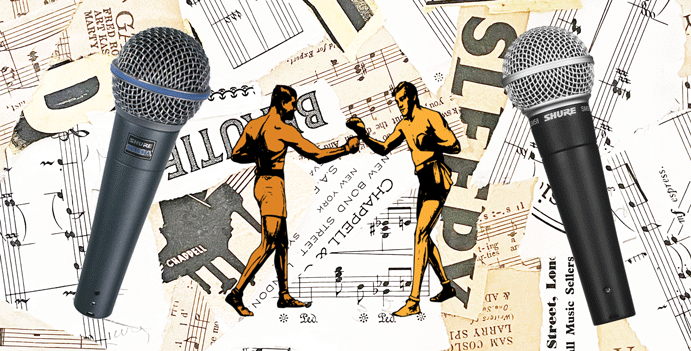
The Shure SM7B is famous for capturing Michael Jackson’s vocals on the Thriller album. But its also very popular for podcasts and live streams. The SM7B was designed as a vocal mic, normally placed on a stand, but sometimes handheld. It’s bigger and much weightier than the SM57, so holding the mic doesn’t have the same feel or look as a slimmer vocal mic like the SM57.
The Shure SM7B also offers low-cut and presence boost switches for refining your sound at source. There’s also more top-end than the SM57, extending upwards to 20kHz, and it has a flatter response through the high-mids.
The SM7B is a very competent mic, with a well deserved reputation for recording spoken word. But it’s much more expensive than the SM57. In a side to side comparison between the SM57 and the SM7B, I was surprised at just how many sonic traits they had in common.
The SM7B sounds a little flatter and has a richer low-end than the SM57, but the differences between the two mics are subtle. With good mic placement, a windshield and some EQ, I think you can get similar results on speech.
Consider also that the SM7B is nowhere near as useful as an instrument microphone. So depending on your needs, you might be better off saving some money and opting for the SM57.
Read the full Shure SM7B review here
Shure SM57 vs Audix i5

The Audix i5 is an intriguing alternative to the Shure SM57. It’s not as well known, but it has earned a solid reputation as an affordable and trustworthy instrument mic. Audix are relative newcomers to the microphone world. The US company was established in 1984, and offer a range of stylish, durable microphones for live and studio use.
The Audix i5 sits in the same niche as the SM5 – a multipurpose dynamic mic that can handle the volume of drums and guitar cabs. Just like the Shure, it has a sleek metal body and a flat-headed grille. However, it’s slightly shorter and lighter than the SM57, and at the time of writing is around the same price.
The i5 and the SM57 have quite a similar sound with just subtle differences in the frequency response. I haven’t had the chance to compare the two mics directly, but some people find the i5 a little brighter or more scooped. This could be due to the small peak at 2.5kHz, and more of a dip in the low mids.
What else do you need?
With any dynamic microphone, you’ll need:
- Microphone stand
Mic stands reduce any handling noise in the studio. Try a good quality boom stand, with a tripod base like the K&M 210/2
- XLR cable
If you want the best quality XLR cables, try these. Go for the shorter lengths where possible.
- Pop shield
If you want to use your SM57 as a vocal mic, simply pair it with a pop shield, for that SM58 sound. A pop shield stops little bursts of air causing bassy pops on your studio recordings. You can easily make one out of stockings, or buy one here.
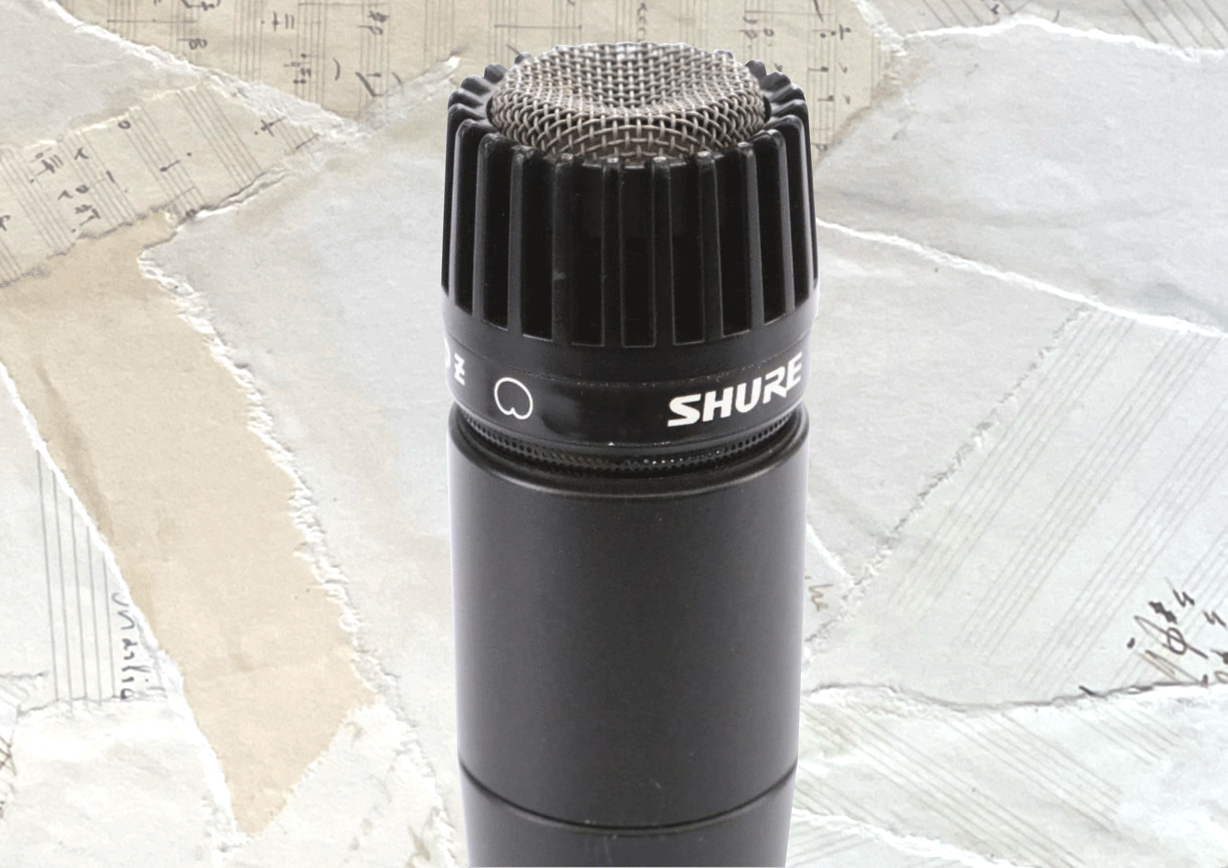
Conclusion
The Shure SM57 has really earned its stripes as one of the most popular and widely used microphones in the world. It’s extremely durable, great at noise rejection, and able to handle even the loudest sounds.
It’s also incredibly versatile – it’s rich and warm tone adapts well to a huge variety of different instruments in and out of the studio. Despite all of this, it’s unexpectedly affordable. making it a great starter mic for beginners, and an essential tool for the pros.
Shure SM57 Frequently Asked Questions
How do I know if my SM57 is counterfeit?
The weight of a counterfeit SM57 is likely to be lower than the 284g of a genuine one. Check the space where both sections of the SM57 screw together – on a real SM57 each section is rounded, leaving a little gap. Also look out for poor print quality on the microphone, box and documents with a fake SM57.
Why is the Shure SM57 so popular?
The popularity of the SM57 is due to low feedback and great side rejection on stage, solid build quality, and versatility in the studio and for live use. It also has a smooth warm sound, can handle high sound pressure levels, and is very competitively priced.
Is the Shure SM57 mono or stereo?
The SM57 is a mono microphone. You can use two of them to create the left and right of a stereo signal.
Can the Shure SM57 be used as a vocal mic?
The Shure SM57 can certainly be used as a vocal mic. Although it’s most well known as a mic for recording instruments, adding a pop shield to the SM57 makes it nearly identical in sound to the legendary SM58 vocal mic.
